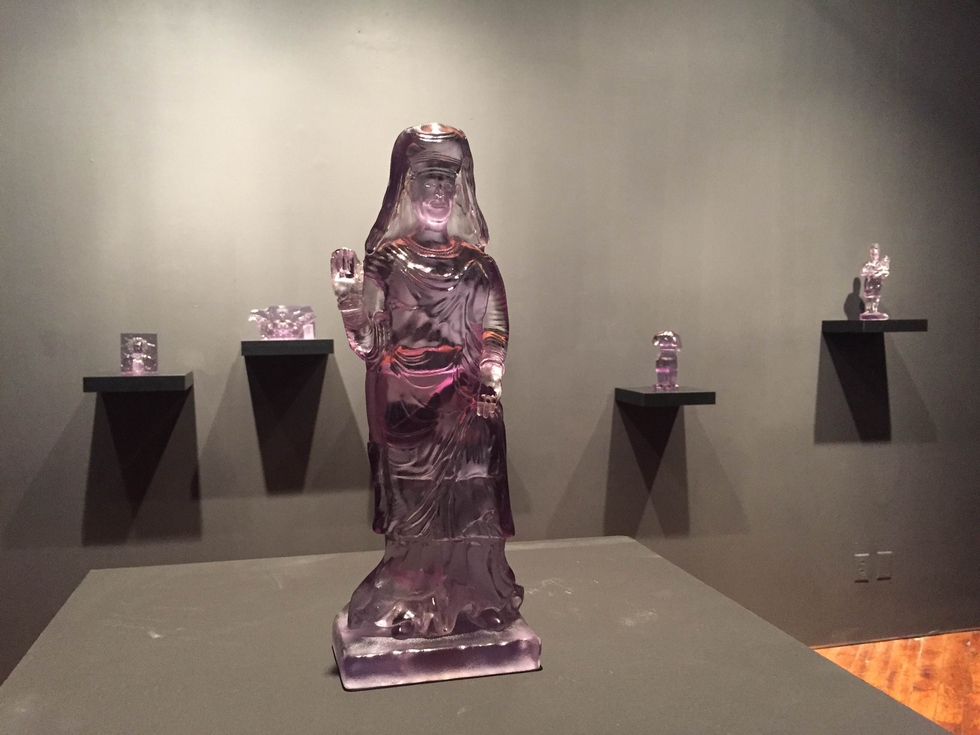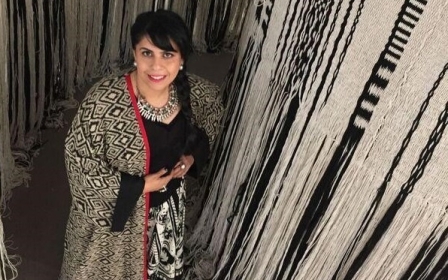Art and activism collide at Iraqi artefact exhibition in Toronto

TORONTO, Canada - The mood is haunting at Morehshin Allahyari’s first solo exhibition in Canada, as a dozen reconstructed artefacts destroyed by Islamic State (IS) group fighters look up from ledges and beneath glass casings.
The historic objects – which include the “Unknown King of Hatra” and “Nergal” – are now transparent, but their intricate details are unmistakable. At their centres they hold photos, maps, videos and other information related to the history of the piece, all contained in either a USB stick or memory card.
Allahyari, an Iranian-born artist based in the United States, has rebuilt the artefacts using 3D printing technology.
“I think about this project as both art and activism,” Allahyari told Middle East Eye in an email interview this week. “Meaning that it has a practical and poetic component to it.”
She said the most challenging part of the Material Speculation: ISIS exhibition – which runs until Saturday at Trinity Square Video gallery in downtown Toronto – was getting information about the artefacts the IS fighters destroyed.
Allahyari spent months researching the items, from their names in English and Arabic to which items were originals or copies, and which had the most historical significance.
She also reached out to archaeologists, historians and scholars in Iran, Iraq, the United States and Europe, including former staff of the Mosul Museum, before eventually choosing 12 original artefacts to reproduce.
“By recreating these artefacts digitally and also bringing them to a physical form using a tool like [a] 3D printer, I respond to destruction as a political and conceptual act of resistance,” Allahyari said.
‘Making meaning of the past’
Sharing information is also a central aim of the exhibition, she told MEE.
Inside each reconstructed artefact is a USB drive and a memory card with information relating to the item. That information is available online, she said, and the drives can also be removed from the reconstructed artefacts themselves.
“I think there is something very important about sharing this project,” Allahyari said.
“The more people 3D-print these, or even keep the information as digital files on their computers, hard drives, flash memories - or read about the history of the artefacts - the more we have collectively resisted the act of forgetting.”
She told MEE she now hopes to find a museum that will preserve the digital files. “I think the concept of collective archiving and collective memory is what I am interested in the most,” she said.
Dina Georgis, an associate professor at the University of Toronto who researches the role of archives and museums in producing and reproducing culture, said she was drawn to the fact that Allahyari did not “let the devastation be the end”.
“To me that is what the work represents: she’s working with the remains of loss and destruction and creating something new, something beautiful, making new meaning from the past,” Georgis told MEE.
She said the exhibition encourages people to imagine new, more hopeful futures – and the innovative use of 3D printing highlights the freedom people should embrace when re-imagining culture and its many meanings.
“People are going to use those remains in different ways, producing new meanings and new cultural expressions. She’s not concerned about culture going in a million directions; in fact, I think that’s the whole point,” Georgis said.
Destruction not limited to IS
The IS group captured international headlines and condemnation last year when videos and images surfaced showing IS fighters smashing ancient artefacts at the Mosul Museum in Iraq’s second-largest city.
The group has been accused of destroying cultural heritage sites and artefacts in areas under its control in Iraq and Syria, including in the ancient Syrian city of Palmyra, a UNESCO World Heritage Site.
Abdulamir al-Hamdani, an official in Iraq’s department of antiquities, said the destruction of Mosul Museum artefacts and IS’s continued control over thousands of archaeological sites across the country constitutes a “disaster”.
“The impact of that is really damaging for human memory. Iraqi heritage does not only belong to Iraqis, it belongs to everybody in the world,” he told MEE in a phone interview from Baghdad.
Al-Hamdani stressed that was not the first major wave of destruction Iraq has faced - American soldiers looted the National Iraq Museum after the US invasion in 2003, he said. “Once they have been taken from the country, they are gone forever. You have to prove that these were taken from Iraq and there is no way to prove that,” he said.
For her part, Allahyari said working on Material Speculations: ISIS came with many complications, given an atmosphere of rising Islamophobia worldwide and the generalisations Muslim communities are subjected to.
She said it was important to remind her audience and the press “that ISIS [IS] does not mean Muslims” and to remember the US military’s destruction of sites in Iraq and Afghanistan and its role in the creation of IS itself.
“It’s easy to get lost in how horrible ISIS is by forgetting the cycle that ISIS is a part of. So in many ways, people in the West would just take this Us vs. Them approach, which I found troubling,” she said.
“I often think that so much of the life I live is stuck in the middle of [these] kind of binary perspectives and all I can do [as] an artist is to disrupt and question that constantly.”
New MEE newsletter: Jerusalem Dispatch
Sign up to get the latest insights and analysis on Israel-Palestine, alongside Turkey Unpacked and other MEE newsletters
Middle East Eye delivers independent and unrivalled coverage and analysis of the Middle East, North Africa and beyond. To learn more about republishing this content and the associated fees, please fill out this form. More about MEE can be found here.






